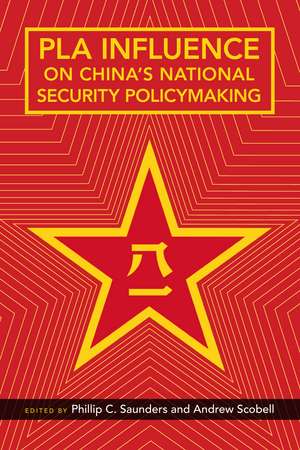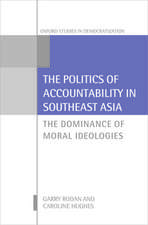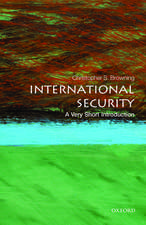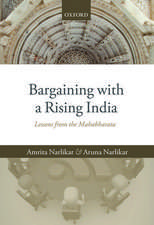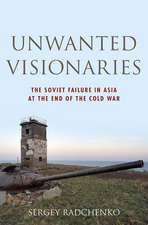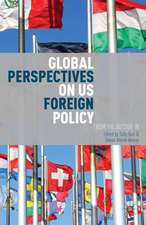PLA Influence on China's National Security Policymaking
Editat de Phillip Saunders, Andrew Scobellen Limba Engleză Paperback – 8 sep 2015
PLA Influence on China's National Security Policymaking seeks to assess the "real" relationship between the PLA and its civilian masters by moving beyond media and pundit speculation to mount an in-depth examination and explanation of the PLA's role in national security policymaking. After examining the structural factors that shape PLA interactions with the Party-State, the book uses case studies to explore the PLA's role in foreign policy crises. It then assesses the PLA's role in China's territorial disputes and in military interactions with civilian government and business, exploring the military's role in China's civil–military integration development strategy. The evidence reveals that today's PLA does appear to have more influence on purely military issues than in the past—but much less influence on political issues—and to be more actively engaged in policy debates on mixed civil-military issues where military equities are at stake.
| Toate formatele și edițiile | Preț | Express |
|---|---|---|
| Paperback (1) | 246.48 lei 6-8 săpt. | |
| Stanford University Press – 8 sep 2015 | 246.48 lei 6-8 săpt. | |
| Hardback (1) | 723.50 lei 6-8 săpt. | |
| Stanford University Press – 8 sep 2015 | 723.50 lei 6-8 săpt. |
Preț: 246.48 lei
Nou
47.17€ • 48.73$ • 39.24£
Carte tipărită la comandă
Livrare economică 19 martie-02 aprilie
Specificații
ISBN-10: 0804796254
Pagini: 360
Dimensiuni: 152 x 229 x 23 mm
Greutate: 0.52 kg
Editura: Stanford University Press
Colecția Stanford Security Studies
Recenzii
Notă biografică
Cuprins
The Introduction examines four trends that have reshaped civil-military relations in China and affected the role of the People's Liberation Army (PLA) in policymaking. It presents two analytic approaches¿one focused on the nature of the issue under consideration, where decisions on that issue are made within the Chinese system, and what role the PLA plays in those decisions, and one focused on the PLA's ability to exert influence at different stages in the policymaking process. After brief chapter summaries, the Introduction presents ten findings, concluding that civilian Communist Party leaders remain in control of the military, but that over the last two decades the PLA appears to have more influence on purely military issues, much less influence on political issues, and to be more actively engaged in policy debates on mixed civil-military issues where military equities are at stake.
In this chapter Isaac Kardon and Phillip Saunders examine whether the PLA can be thought of as an interest group, finding that factors which previously limited the PLA's ability to act as a coherent policy actor have diminished. Today's PLA demonstrates numerous characteristics of an interest group, including professionalization, growing coherence of its corporate interests, an expanding monopoly on national security expertise and information, and enhanced capacity to articulate and defend institutional goals and equities in order to shape public debate and influence policy.
In this chapter Alice Miller explains the political logic behind the transformation of the Chinese leadership's decisionmaking system, emphasizing a deliberate effort by Deng Xiaoping in the 1980s to establish an effective collective leadership system with checks and balances to prevent attempts by any individual member¿and especially by the party general secretary¿to dominate the others. She argues that these reforms have transformed civil-military relations from "subjective civilian control" to "objective civilian control" as the PLA's influence on political decisions has narrowed into institutional mechanisms focused on security issues. These structural changes limit the ability of PLA leaders to exert influence on political issues or to exploit potential splits among top civilian leaders.
In this chapter Tai Ming Cheung uses new sources to describe the inner workings of the secretive Central Military Commission (CMC). He identifies key political and organizational principles guiding the CMC's development; describes its current structure, workings, and responsibilities; highlights the critical role played by the CMC vice-chairmen; evaluates Hu Jintao's role as CMC chairman and problems in civil-military relations during his tenure; and conducts an initial assessment of Xi Jinping's early tenure as CMC chairman. Cheung stresses Xi's emphasis on the role of military power in a "strong China dream," efforts to impose stricter political and fiscal discipline, and decision to restructure the military command system to improve its ability to conduct joint operations.
Nan Li's chapter assesses how Jiang Zemin and Hu Jintao exerted influence over the PLA, and analyzes why their methods differed. He distinguishes between two approaches: "currying favor" by catering to PLA interests and "imposing will" by forcing the PLA to do things it would not otherwise want to do. He argues that Jiang curried favor early in his leadership and then imposed his will, while Hu curried favor throughout his tenure. Nan Li suggests Xi Jinping is likely to curry favor initially to consolidate power, but then to impose his will by downsizing and reorganizing the military.
Michael Swaine assesses the limited information about the PLA's role in China's foreign policy and political-military crisis behavior. He begins by examining the changing relationship of the PLA to the overall PRC political power structure and then reviews the PLA's role in foreign policy, looking at both senior-level and operational-level interactions. He examines five aspects of the PLA's role in crisis decisionmaking and implementation: upper-level participants and processes, lower-level actors, intelligence and information flows and preexisting plans, research institutes, and unplanned or uncontrolled behavior. Swaine challenges the view of a PLA that wields a decisive influence, noting that the PLA's strongest avenue for influence is through the Central Military Commission (CMC). Lack of an effective NSC-like structure raises doubts about adequate coordination and oversight of PLA operational activities such as weapons testing and military actions outside China's borders.
Bonnie Glaser assesses the extent of the PLA's influence on the PRC's cross-Strait policy and the avenues the PLA uses to influence that policy. Acknowledging the difficulty in judging whether the PLA's attempts to exert influence are successful, Glaser identifies ten methods the PLA uses to shape Taiwan policy. These include using its institutional representation in the CMC and other policy bodies, intelligence and research, military procurement, military exercises, official statements, defense white papers and other official documents, media exposure, informal mechanisms, cultural and social exchanges, and military-to-military channels with third-party countries. Glaser suggests that the CMC is the most important avenue by which the PLA attempts to influence China's Taiwan policy, with intelligence and research and defense white papers being the next most effective avenues.
Andrew Scobell addresses the PLA's decisionmaking role on Korea issues by analyzing the 2002¿2003 "second nuclear crisis" and the 2010 ROK Navy Cheonan crisis. Scobell argues that Chinese leaders place a high priority on stability, view the DPRK as volatile, and believe policy changes might destabilize the relationship and the region. China is therefore likely to maintain its current DPRK policy unless a crisis arises. Scobell notes that China and the PLA struggle to influence the DPRK. Because the military largely agrees with the party's overall Korea policy and with keeping the DPRK as a buffer state, it is difficult to assess whether the PLA has much independent influence on China's DPRK policy. The chapter concludes that China is unlikely to change its North Korean policy and that "maintaining stability both inside China and on its periphery is the highest priority" of China's leaders today.
Eric Hagt assesses the PLA's role in China's increasingly active military diplomacy by surveying its international activities and examining the relevant institutions and individuals. The three key elements are the General Staff Department (GSD) Foreign Affairs Office, the senior PLA officers who supervise military diplomacy and military-to-military (M2M) activities, and the PLA officers involved in military diplomacy. Hagt argues that the PLA focuses on Chinese strategic objectives rather than on building stable bilateral relations. Chinese military diplomacy sometimes complicates overall Chinese diplomacy and can produce outcomes incongruent with the objectives sought by the foreign affairs system.
M. Taylor Fravel examines the PLA's influence on China's territorial and maritime disputes, arguing that the PLA is limited to bureaucratic influence within existing policymaking structures and processes. PLA actions in contested waters reflect the consensus of top CCP leaders, not independent military decisions or actions. Fravel traces the PLA's relatively limited role in previous territorial disputes, including border consolidation following the Chinese civil war and Beijing's initial claim over the Senkakus. In current territorial debates in the East and South China Seas, there is little evidence that the preferences of civilian leaders and the PLA differ; there are examples of Beijing utilizing diplomatic and political tools rather than military instruments to assert its territorial claims.
Christopher Yung argues that the PLA Navy lobby sought to influence the 1988 decision to use force against Vietnam in the Spratly Islands; the decision to acquire an aircraft carrier; and the 2013 decision on centralizing the functions, command and control, and management of China's "maritime sovereignty" activities. In the first case, the PLA got what it wanted by presenting a unified PLA opinion to CCP leaders without alternative options. The PLA's initial advocacy of acquiring an aircraft carrier was rebuffed, but the PLA sought and eventually received "friendly guidance" from leadership to achieve its goal. In the third case, the results were mixed as CCP leaders did not agree to centralize enforcement activities under PLA Navy control, but did pay more attention to maritime sovereignty issues and seek to improve coordination.
Linda Jakobson examines how the PLA works with civilian maritime security agencies. In addition to the military, a wide variety of government bodies associated with maritime law enforcement, maritime security, and maritime economic development attempt to influence maritime policy. Her research reveals a noteworthy increase in interactions between the PLA and maritime law enforcement agencies since the March 2013 restructuring that established the China Coast Guard, including joint training, research, and drills. The PLA Navy is attempting to influence decisionmakers directly and to shape public opinion on maritime security issues by engaging with civilian law enforcement, government ministries and agencies, state-owned enterprises, and universities. Jakobson concludes that uncertainty remains over how the restructuring of the maritime law enforcement agencies will affect interactions with the PLA due to the opacity of the PLA command structure and the difficulty of achieving "jointness" between military and civilian agencies.
